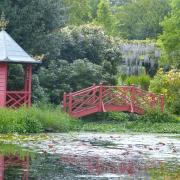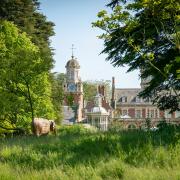A regular art workshop from Suffolk artist Richard Nichols
A regular art workshop from Suffolk artist Richard Nichols
If you’re longing to paint but don’t really know where to start, or you’ve dabbled a bit and want to improve, Suffolk artist Richard Nichols could be just the man you need to meet.
Richard, who was born at Hadleigh and is now based in Great Glemham, runs courses and workshops for enthusiastic painters of all abilities in Suffolk as well as further afield.
Passionate about art – and highly appreciative of his own natural ability with a pencil and brush – he’s keen to share his knowledge and skills with others. He loves guiding people through the pitfalls of drawing and painting so that, in his words, "they achieve what, for many, seems an impossible dream of creating their very own work of art.
"With patience, careful guidance and encouragement I do believe everyone has it in them to create artwork to a satisfying result – whatever the subject," he says.
Richard draws much of his inspiration from nature, loves capturing wonderful Suffolk skies and is especially attracted to the sea.
Many of the Suffolk locations for his workshops involve coastal settings including Southwold, Aldeburgh, Snape, Dunwich and Woodbridge, the waterways of Constable country, as well as in our wonderful countryside and at historic venues such as Framlingham and Lavenham.
He also arranges special celebration events where guests are encouraged to ‘take part in art’ by making a few brush strokes on a large scene he has drawn up to mark the occasion. Richard takes groups to other parts of Britain and tutors aboard a sailing barge on the Alde and Ore, as well as on the luxurious Star Clipper sailing ships, travelling around such places as the Greek Islands, south of France, Corsica and Sardinia, Venice and the Adriatic. This autumn and winter he will be sailing to the Caribbean in December and Spain and Morocco in October and there’s still time to jump on board.
For Suffolk Magazine Richard is staying on dry land to present each month a step-by-step art class. This is your invitation to have a go, helped by Richard, who will guide you through the various stages of creating your own artwork with some of the tips and techniques involved.
Artful agapanthus
As an artist my love and appreciation of all things natural spans many subjects and I first fell in love with these wonderful flowers in the early stages of my solo Around Britain project when working on the Scilly Isles, where these splendid plants almost overtake wild hedgerows, with tall, willowy stems waving their bulbous blue flower heads in the west country breeze.
Then came the challenge of growing the agapanthus at home in Suffolk. Planting in pots gives variable positioning possibilities as well as a chance to add protection in winter and, of course, great opportunities to capture their beauty with pencils and brushes indoors if it’s raining!
From the deep purples to white flowers I chose a mid-blue variety with golden stamens, so the first step was to isolate the actual content of my study and decide how much – or how little – to include. Best not to overload too early.
The graceful tubular stems tend to disappear when viewed against green grass, so the pot was moved to give a darker, more contrasting background. I chose to draw in ink to give a punchy feel against the delicate flower colours.
It is also a useful habit to study any subject a little closer to see how it is actually put together then start by following the "construction lines" of the plant, as this will create a much more natural looking end result.
Step 1
This initial sketching can be done with a soft B or 2B pencil if you are not too confident with the pen, which in this case is a simple black ballpoint, being careful to work lightly and not press too hard into the watercolour paper base.
Building up detail and checking things like size and length of stem against the flowers for example, helps to get proportions right overall.
Step 2
Then add some light touches of violet/purple along the petals before a pale green underwash on the stems brings the composition to life without using dominant colours too early.
Together with some pre-planning, the layering technique is one of the great things about watercolours, because you get a chance to build up the tonal strength of a piece of work gradually. For crisp, clean lines the layers should be dry before this is done but wet-into-wet produces pleasing blends of colours as they merge into one another).
Step 3
If, as on this agapanthus study, the ink has already set the darkest shade and the intention is for a delicate rendition of the subject, it is important to keep colour strengths lower by mixing a higher ratio of water to pigment.
Watercolour pencil is used in conjunction with paint to give a degree of flexibility that will create a coloured illustration rather than a painting – we’re not intending a botanical illustration which requires totally accurate detail. The aim is to enjoy your art and not aim too high, especially when starting out.
The finished picture can be window mounted and framed to enhance the colours and even cut down or masked off to exclude any areas which do not appear necessary, such as the lower buds on this agapanthus, making a squarer format which in itself is a nice alternative to that well used oblong.
Your challenge . . .
Choose a favourite plant or flower currently in bloom and create your own painting or coloured sketch of it. There are a couple of ideas here which Richard has started of current flowers so why not spend some time studying what’s around you – perhaps in a little more detail than normal – and create your own masterpiece?
If you’re taking up the challenge of Richard’s art class here we’d love to see the results! Photograph or scan your finished painting and email us some images. Send them to suffolkmagazine@archant.co.uk We’ll publish a selection in future issues of the magazine.
Share your art in Suffolk magazine
Do you have a favourite place or subject in Suffolk that
you like to paint?
Why not share it with others?
We’d love to hear from keen artists, painters and sculptors, as well as from art clubs around the county. Send us examples of your wrok and we’ll publish them in a ‘gallery’ in Suffolk Magazine.
You can email jpg images of your work to: suffolkmagazine@archant.co.uk
or send examples to us at 30 Lower Brook Street, Ipswich, Suffolk IP4 1AN


























